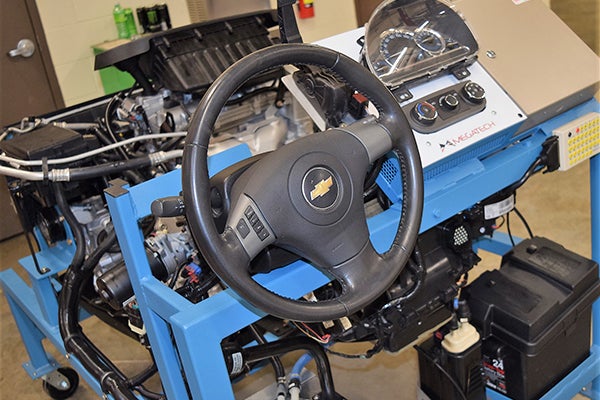New SMC auto teaching tool built for diagnostics, not speed
Published 12:00 pm Saturday, May 14, 2022
|
Getting your Trinity Audio player ready...
|
DOWAGIAC — With a wheeled frame, an accelerator and a steering wheel, it looks like something Tim “The Tool Man” Taylor rigged up for bed-racing. Or, with its plethora of plugs, the mobile audio/visual cart which rolled around your middle school delivering overhead projectors.
As with most things, though, first impressions can be deceptive. The newest addition to Southwestern Michigan College’s Automotive Technology program isn’t built for speed, but diagnostics. A $23,000 teaching tool, the performance simulator is manufactured by Megatech of Tewksbury, Mass.
The steering wheel displays a Chevrolet emblem because this trainer mimics a 2007 Chevy HHR, a compact sport utility vehicle reminiscent of the retro-themed Chrysler PT Cruiser if it had a body.
“Essentially, this has a four-cylinder, General Motors Ecotec engine,” Associate Professor Jeff Robson said. “What’s good about it is everything’s modern as far as fuel injection, the ignition system and the communication system between the body-control module and the engine-control module. Cars today have 50 to 60 different modules. This one is integrated with an air-conditioning unit so the compressor runs and students can watch the liquid and gas come out of the evaporator. It’s got electric power steering and automatic transmission and you can easily get to the components.”
Robson is marking 40 years in the industry after graduating from Niles High School in 1980, and Ferris State University in 1982. Before teaching, he was a service manager for 25 years.
Robson flips up a panel he unlocks with a key to disclose 12 “faults” to test, like robots programmed for nursing students to practice responding to different scenarios in a safe environment.
“We can pick faults for technicians to diagnose,” he said. “This switch interrupts the crankshaft position sensor. We can disable the fuel pump. The compressor clutch for the air conditioner. The pressure sensor on the fuel tank, so they can do diagnosis for check-engine lights. Interrupt an injector. Throttle position sensor so it won’t accelerate. Oxygen sensor to interrupt the fuel control system. Manifold pressure sensor. Accelerator pedal position sensor. Air-conditioning refrigerant sensor. Coolant temp and intake air sensor. We can induce faults, lock it up and have them do the diagnosis. As well as a dozen different things, we can do variables with multiple faults.”
Before, they used an actual car parked in the Jan and A.C. Kairis Building classroom on the Dowagiac campus.
“Portions, like the dash, had to be disassembled with wiring harnesses pulled up to get access to the connections,” Robson said. “This is easier and saves time. I teach electrical and engine performance, (Associate Professor) Kyle (Schrock) teaches the air-conditioning class and the introduction to engines class. Taking off a serpentine belt is relatively easy with this.”
According to Robson, 40 to 50 percent of his students have never touched a car before enrolling in the program.
SMC offers both a one-year certificate program, which prepares students for entry-level positions, as well as an associate degree, which offers more job and advancement opportunities. SMC is still accepting students for the Fall 2022 class; those interested can apply for free at swmich.edu/apply.







